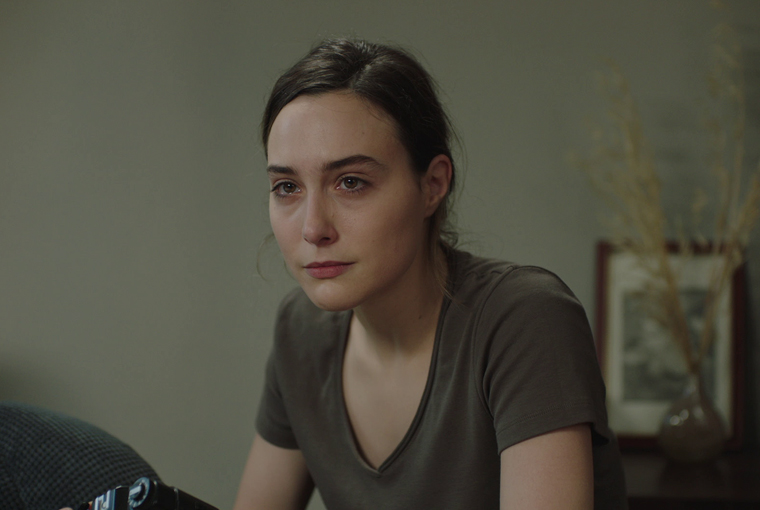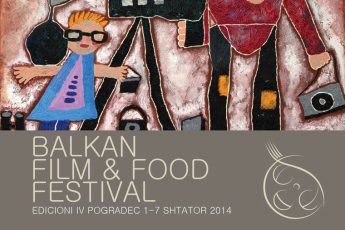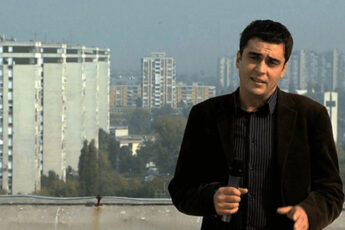Loosing Channels of Communication
Gentian Koçi’s A Cup of Coffee and New Shoes On (Një flixhan kafe dhe këpucë të reja veshur, 2022)
Vol. 142 (February 2024) by Margarita Kirilkina
Grown-up twin brothers are lying face to face in fetal positions on one side of the bed. On the other side is a young woman, facing away in a different direction. This is one of the most symbolically rich and visually powerful scenes in the film A Cup of Coffee and New Shoes On by Albanian director Gentian Koçi. The brothers blend into a figure resembling an unborn human, while the woman represents the image of the eternal mother, providing the opportunity for the embryo to enter the world of communication.
The film tells the story of two brothers, Gezim (Edgar Morais) and Agim (Rafael Morais), who, despite suffering from deafness since childhood, function perfectly in a hearing society. Well-adapted to the world of sound, they reproduce gestures that are associated with the relevant noises: they slam doors when angry, tap glasses on the table after downing shots. One day, Gezim learns that due to a rare disease, he will soon lose his sight. The tragedy is that this genetic disease awaits Agim as well. Gradually, first Gezim and then Agim become blind, trying to adapt to a world where there is no longer any open channels of communication for them, neither through speech nor through the sign language. If the inability to hear can be tackled, and a deaf person can continue to live their lives, then in a world consumed by visual culture, the loss of sight comes with thorough isolation. All that remains for Gezim and later Agim is touch, and the tactile gestures through which the brothers communicate with each other evoke a sense of unease in a world of Covid-19 where physical contact brings death.
The inseparability of twins in a world that celebrates individualism above all else, also generates a sense of anxiety. The adult brothers repeatedly affirm that they will never leave each other, that means that they will never grow up, remaining in the “naive” world of childhood. Their gestures toward each other are filled with childish tenderness and, at the same time, infantile cruelty. When Agim finds Gezim sitting on the balcony railing, he pulls him back to the room, and a fight ensues, only ending when the weaker one starts to cry. Nevertheless, the infantilism in this film gains strength. Only by remaining in a childlike state, devoid of adult communication, do Agim and Gezim find a certain freedom, being left completely alone in a wooden house in the forest after having been brought there by Ana (Drita Kabashi), Agim’s girlfriend. Absolutely devoid of language, constructed by society as a manipulative tool, the brothers, abandoned by their mother, invent their own means of communication. When the spectator sees them in despair, they finally laugh at their inside joke that is unintelligible to everyone except themselves.
The film mostly takes place in confined spaces, symbolically referring to the body in which a person is trapped and that they cannot escape, thus losing the ability to connect with the outside world. The apartment with its narrow corridors, bathroom, and in-between spaces where the action often unfolds is claustrophobic, reflecting the feelings of the brothers as prisoners of their own bodies but also of the body of society. The only place where Gezim gets moving is the empty autumn beach, while in the city apartment, everything becomes an obstacle for him. Here, nature is the womb of the mother, the place of the prenatal existence of humans, where there are no rules, and there is no language. This elemental force requires no communication, and it is the only place where the brothers are entirely free.
The film has few dialogues, and with the gradual blindness of the twins, they almost disappear. Thus, the film returns to the origins of cinema, to silent cinema that speaks the language of images. This return to the original fundamentals of film reaches its peak in the scene of Gezim’s medical examination when he is lying down, surrounded by dark space, and we see only his face in close-up. The face is illuminated by bright light that changes colors. This scene could be part of an experimental film in which the image holds both narrative and symbolic meaning. Here the film reaches a cathartic moment, after which the visual world, the world of communication through language and images, will soon vanish for Gezim and Agim, ultimately returning them to their natural state in a prenatal world.




Leave a Comment